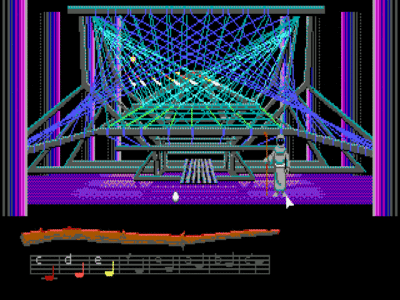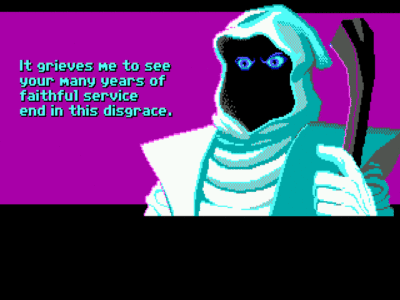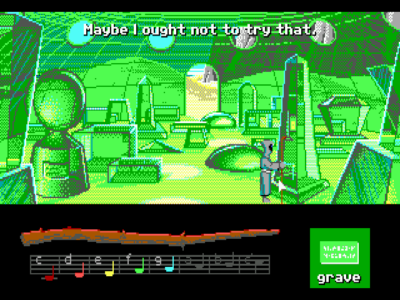
Loom
Written by: Stoo
Date posted: September 18, 2007
- Genre: Adventure
- Developed by: Lucasarts
- Published by: Lucasarts
- Year released: 1990
- Our score: 7
Recently Rik and I were discussing the much loved Lucasarts graphical adventures. Once the company had gotten into their stride they churned out a quality range of point-and-clickers, and are thought by many to be the greatest makers of adventures. That is unless you’re a hardcore Sierra fan but whilst that lot had their moments too, they just weren’t a match for the wit, imagination and better-balanced gameplay of Lucasarts’ works. So we’re quite keen to have the entire range covered one day – and in fact at the time of writing we’re past halfway there.
Rik’s more the adventure expert here, so you can already see more reviews under his name than mine in this genre. Still, I like to take a break from grinding away in RPGs or being an utterly useless general in strategy games, for the more relaxed pace and involving story of a good Lucasarts game. So for the immediate time being we were dividing up the remaining games between us to play and review. Rik got Indiana Jones and the Last Crusade and I think he drew the relatively short straw. It’s not a terrible game – none of the Lucasarts titles were – but it is rather frustrating in places. Myself I picked the follow up Fate of Atlantis, which I think most would regard as a superior title. That leaves the last Monkey Island, Grim Fandango, maybe the really old ones, and we’re almost done. Then I thought to myself… Loom! We’d somehow managed to overlook that one; neither of us played it first time around, and while quietly respected it never had the prominence of Monkey or Indy.
So I sat down to have a go, unfettered by nostalgic memories of playing it in 1990. I can’t deny a more general fondness for the days of ye olde graphics and bleepy adlib sound but, well, that’s just something you have to accept when reading this site. You’ll tell from the screenshots that I was working on the original EGA release – it was later re-released in 1992, featuring VGA graphics and digitised speech. I’m told though that that version has reduced dialogue, and cut a few other features as well.

The Loom itself, focal point of the Weavers’ power.
To sum up the nature of Loom, it’s a fantasy story with some fairly dark undertones. It’s set in a world that could be a mythical past or a post-apocalyptic future; that bit is never really made clear. Here humanity has banded together into guilds such as shepherds and glassblowers, each guild effectively running a small city-state of its own. Beyond their towns, dangers such as dragons, power-crazed tyrants and more ethereal forces lurk. The player takes control of Bobbin Threadbare, a young lad born into the guild of Weavers. The guild’s talents in fact go far beyond weaving cloth; they are the shadowy custodians of the fabric of reality itself.
The game starts with Bobbin summoned to a meeting of the guild elders; here we learn that they are in fact very worried. They’ve seen a coming chaos, a time of darkness, and have for various reasons decided he’s responsible. But before they can decide his fate (which probably won’t be good) they punish the old lady who raised Bobbin and taught him their skills, by turning her into a swan egg. Then a swan appears. Then the elders all turn to swans. And they fly off. And if you’re thinking “wait, what?” then don’t worry, so was I. The game was originally accompanied by a 30-minute audio drama which helps fill in a lot of the background to this world, and to Bobbin himself. Without that, you might feel a bit confused at first. Stick with it though, and I can assure you that events will become a bit more clear.
From here, you progress into a game that has real charm. At the core is Bobbin’s journey; on one level he’s simply trying to find his people. However there are also issues of life and death here, and of higher levels of existence. It’s whimsical in places perhaps, but never falls into the traps of being cute or twee, and also there are a few rather grim moments. Just like a good non-disneyfied fairytale, perhaps. The presentation helps a lot; even in the old-skool EGA the artwork is of a good standard. The glassmakers’ city is brilliant greens; in contrast the the weavers’ isle is shrouded in night, a place of black and purple tones. Seeing the swans cross the moonlit sky is a rather haunting moment.
Bobbin himself meanwhile is likeable – an important factor for a successful adventure. If you’re spending several hours in the company of your hero, you really need to feel some amount of empathy with them. Bobbin then is a juxtaposition of the powerful and the vulnerable. On the one hand he’s a Weaver, wielding terrible arcane powers that others hold in great awe. He can tear holes in the universe, and raise the dead. His face is forever hidden beneath his cowl, further lending him a mysterious air. Yet also he’s a good-natured sort, mild-mannered and willing to help where he can, and even a bit naïve. He’s a 17-year old lad who’s some way out of his depth, and hasn’t yet mastered his abilities, but he’s determined to find those swans.
Also, this game along with Monkey Island established Lucasarts’ dedication to a gaming structure game where your character cannot die. The idea is you cannot take a “wrong” action – or at least not with any consequences beyond “that didn’t work”. Thus you cannot fail in any real manner. The game then is about immersing yourself in the story and the world before you, and solving the puzzles at your own pace. When you think about it there’s not a lot of difference in practical terms between falling off a cliff and having to reload and try something else, and just sitting at the top of the cliff trying to find the right action to take you out of there. In terms of player engagement with the game though it does make a psychological difference. It just feels more encouraging, like the game wants you to eventually succeed.

An elder Weaver looking unimpressed.
As well as being imaginative in story and themes, the same can be said about the game’s interface. For one thing while there’s plenty of dialogue, you never get any choices in what to say. Also, there’s no inventory – you don’t carry any items except for your distaff. Thus, two main approaches to puzzle-solving are discarded. Instead the distaff is used to cast “draughts”, essentially magical spells that are executed by playing a sequence of four notes. Doing this is easy enough – your staff is drawn across the bottom of the screen, and clicking different parts of it plays notes of different pitch.
These draughts are used to manipulate the world around you. One opens doors, another dyes cloth green, another turns you invisible. The first few draughts only use the lowest three notes, but as you progress higher notes become available and new draughts with them. The clever bit is, many of these can be reversed. Play the dyeing draft backwards, and you’ll bleach an object instead. Oh, if you’re now wondering why Weavers play music, I never worked that out either. Just run with it.
So then there are a lot of positive signs. Half an hour into the game, I was thinking I might be onto something quite special. A couple of hours later and… I was watching the credits roll already. To be sure, a lot of older adventures are actually quite short in terms of content. They padded themselves out with tricky puzzles, and if you know exactly what to do you can rattle through in an evening. However I was encountering this one for the first time and still cruised through it, without a single problem slowing me down for more than a few minutes. For the record, I’m speaking as someone who normally wimps out and runs to gamefaqs at least once or twice.
Most puzzle solutions are pretty simple and obvious. Also, since you have no dialogue options, that effectively removes an avenue of problem solving you’d often see in a Lucasarts adventure. Beyond that though, there just aren’t many puzzles in the first place. There are some major events that happen where Bobbin is put in danger, yet you hardly interact with anything for their duration. Which just feels like a cop-out. Walk back and forth a bit, click to continue, watch some dialogue and that’s it; immediate crisis resolved with no input on your part.
In some ways, it feels a bit perverse to slam Loom for being too easy, when a common criticism of older adventures regards frustrating difficulty. Arbitrary deaths and timed puzzles were a constant threat, especially in the Sierra stable. Then there was that old trick of becoming utterly stuck because you’d failed to find a required item or complete some task earlier in the game, which you were never told was necessary, and you weren’t allowed to go back and rectify the mistake. I certainly don’t miss that. Also it’s interesting to read the reviews on Mobygames – a lot of people acknowledge Loom’s simplistc nature, but go ahead and praise the game profusely anyway. Their view is it just doesn’t matter, that we’re here for the atmosphere and the story, not struggling for hours over mindbending puzzles.

Bobbin has a bit more sense than I do, and refuses to cast the “opening” draught on a grave.
So to some extent I can forgive the shortness; and call me a wimp but I generally prefer too easy to too hard anyway. Also, let’s be honest here, many of us will have (ahem) aquired this from abandonware sites anyway, so it’s not like the disappointment of finishing a £30+ game in an evening. I guess I’m just annoyed because, I enjoyed what I saw enough such that I really wanted *more*. More puzzles and challenges for one thing. Also though, the story is certainly good by gaming standards, but it could still have been expanded. It makes a start on exploring the various factions, and building relationships between Bobbin and certain characters, but it feels rushed, and so much more could have been done.
So then; short, easy, and you’ll probably finish it in an evening. However there’s still overall lots to recommend this one. It’s incredibly atmospheric, even beautiful in places for all the chunkiness of the technology. It sets out to tell an engaging story and has moments of genuine feeling. I couldn’t say such things about Sierra’s endless Quests. I just wish there was about twice as much of it. So even if Loom falls a little short of being a classic like Day of the Tentacle or Monkey Island, it’s still certainly worth your time.


 Posts
Posts